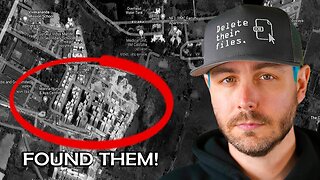Premium Only Content

They're Rebuilding King Solomon's Temple
To meet the requirements of the Old Testament law, a red heifer was needed to help accomplish the purification of the Israelites from uncleanness—specifically, the ashes of a red heifer were needed (see Numbers 19). Because red heifer ashes were necessary for the purification rites held at the temple, many have regarded the appearance of a red heifer today as heralding the construction of the third temple and the return of Christ.
According to rabbinical tradition, there have been nine red heifers sacrificed since Moses’ time. Since the destruction of the second temple, no red heifers have been slaughtered. The rabbi Maimonides (1135—1204) taught that the tenth red heifer would be sacrificed by the Messiah Himself (Parah Adumah, ch. 3, § 4). The Temple Institute, a group advocating the construction of a third temple, reports that five flawless red heifers from Texas arrived in Israel on September 15, 2022 (https://templeinstitute.org, accessed 9/22/22). Many people view this event as a fulfilment of prophecy, since the acquisition of a red heifer is a major step forward in plans for a new temple.
The Mosaic Law specified that the red heifer was to be “without defect or blemish” and to have never borne a yoke (Numbers 19:2). The sacrifice of the red heifer was unique in the law in that it used a female animal, it was sacrificed away from the entrance to the tabernacle, and it was the only sacrifice in which the color of the animal was specified.
The slaughtering of a red heifer is described in Numbers 19:1–10. Eleazar the priest was to oversee the ritual outside the camp of the Israelites. After the animal was killed, Eleazar was to sprinkle some of its blood toward the front of the tabernacle seven times (verse 4). Then he left camp again and oversaw the burning of the carcass of the red heifer (verse 5). As the red heifer burned, the priest was to add “some cedar wood, hyssop and scarlet wool” to the fire (verse 6).
The ashes of the red heifer were then collected and stored “in a ceremonially clean place outside the camp.” The ashes were used “in the water of cleansing; it is for purification from sin” (Numbers 19:9). #christiantiktok
-
 1:03:38
1:03:38
vivafrei
20 hours agoElection RECAP! Long-Count Chicanery! FULL Jan. 6 Pardons! Let's Mock Lichtman & MORE! Viva Frei
172K171 -
 DVR
DVR
Vigilant News Network
15 hours agoDoctors Drop Post-Election COVID Bombshell | Media Blackout
176K -
 14:13
14:13
Scammer Payback
12 days agoTelling Scammers Their Address
165K92 -
 5:43:21
5:43:21
Barstool Gambling
19 hours agoBig Cat and Co Sweat Out the Week 10 Sunday Slate | Barstool Gambling Cave
124K7 -
 2:49:36
2:49:36
The Jimmy Dore Show
2 days agoRumble Time Live w/ Jimmy Dore & Special Guests Roseanne Barr, Dr. Drew, Drea de Matteo & More!
586K713 -
 17:17
17:17
DeVory Darkins
1 day agoKamala Post-Election BOMBSHELL Exposes $1 BILLION Campaign DISASTER
110K259 -
 19:52
19:52
Stephen Gardner
1 day ago🔥HOLY CRAP! Trump just did the UNTHINKABLE!!
110K688 -
 4:34:55
4:34:55
Pepkilla
19 hours agoBlackops Terminus Zombies Boat Glitch
159K10 -
 5:50
5:50
CapEx
1 day ago $26.19 earnedWhat the Coming & Inevitable Sovereign Debt Crisis Means for YOU | CapEx Insider
141K39 -
 1:34:00
1:34:00
Tactical Advisor
20 hours agoAR15 Giveaway WINNER/Trump Winning | Vault Room Live Stream 008
98.5K44